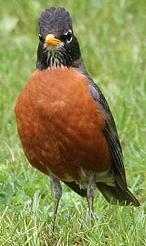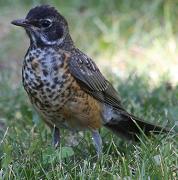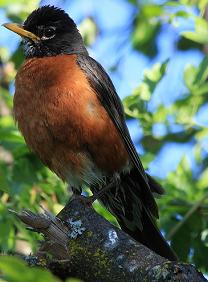American Robin
Food and water will attract Robins to your
yard. Add the right trees and shrubs ,and the birds could nest
in your backyard.
American Robins are a sign to many people that spring has
arrived. They are one of the most familiar birds to
birdwatchers. It is a
treat to watch this red-breasted bird run, and hop around the lawn
looking for worms or other insects. You see them cock their
head to one side and you know they have found a worm.
Identification - Pictures and Video
(Classification: Turdus migratorius)
Robins have a dark gray back with dark stripes on a white
throat. Their bright red to orange breast makes them stick
out. The head and tail of the male are black. The female is a
little grayer, and not as brightly colored.
Young birds will
look the same except for a breast speckled with black spots.
Photos by Keith Lee. The camera I
use is the Canon EOS 40D.
The American Robin is the largest thrush in
North America. Adults are 9 to 10 inches.
The bird was given the name Robin by the
early settlers, who thought that, with its reddish breast, it
resembled the English robin.
Song
Robins have a clear cheery sound with a number of songs, and
calls. Many people are familiar with their cheer up, cheer up
sound. They are one of the first birds to begin singing in
the morning, and one of the last to be heard at night.
The male is the most vocal especially during courtship.
The territory or whisper song is a soft hisselly-hisselly
sound.
American Robin song Sound
American Robin song 2 Sound
The mating song of the male is accompanied by
him displaying and lifting his tail higher than his head.
Photos by Keith Lee. The camera I
use is the Canon EOS 40D.
Habitat
American Robins can be seen in residential neighborhoods,
parks, forests, and farmlands throughout much of the U.S. for
most of the year. In the fall and winter robins may
gather into huge flocks of hundreds of birds. Many
robins move to woods where berry-producing trees and shrubs
are common during winter.
Nesting and Breeding
During courtship the male feeds the female. They also
do gaping, where the males, and females approach each other
and touch widely opened bills. Of course, there is much
singing.
The birds like to nest in open woodlands,
grasslands with scattered trees, and your backyard. Robins
make a bulky nest of coarse grass, weeds, twigs, and mud lined
with fine grass. Breeding is in early April in the south to
mid-may in the north. Females do most of the nest building.
You can find their nests in the forked branch of a tree or
shrub, on the ledge of a building or cliff, or even on the
ground.
Most videos on my site were taken with the Canon
HG10 camcorder.
Food and Feeding
Robins eat mostly insects, fruits, berries, and
earthworms. Much of their foraging is on the ground but
they also forage in trees.
How to attract Robins to your backyard
Water will attract robins and many other birds.
Robins love a birdbath, especially if there is running water, and
they are fun to watch as they drink and
bathe. You will often see them under a sprinkler.
Here is great selection of bird
baths and garden fountains.
Plat form feeders are good. Robins will eat apples,
grapes, other fruits, and suet. They will also come to feeders
with seeds, doughnuts, bread, peanut butter mixtures, and many
other foods.
Natural food sources in your yard will attract them.
A
damp lawn will have earthworms. A pile of leaves or brush
will have worms, and other insects they love such as
caterpillars, grasshoppers, and beetle grubs. A good way to
supply an area for them to forage in is to use fall leaves as
mulch in your flowerbeds. Keep in mind that pesticides are
harmful to birds.
Planting berry bushes, and fruit trees is a good idea
because a large part of
their diet is fleshy fruits and berries. A yard with natural
fruit sources will be returned to over and over.
Robins will use a nesting shelf to build their nest
in. This shelf can be attached to the side of a barn, garage,
or under the eaves of a house. Since the female lines the
nest with mud it is good to have a source such as a
garden.
A nesting shelf can be made from three boards nailed together
to form the floor, back, and roof of a house. Make it about 7
inches by 8 inches wide, and 8 inches high. Mount it in a shaded
spot. A good place is on the side of your house under
overhanging eaves.
Roosting or resting in trees, is common
for these birds. Groups of roosting robins may contain
twenty to a few hundred birds,
especially in winter. Roosting helps protect them from
predators, and they will often roost with other birds such as
starlings. Robins are highly migratory birds and can
often be seen in large flocks.
 Check out Robin posters
Check out Robin posters
For more on food
and feeding click here.
For more on feeders click here.
To learn about other favorite
birds click here.

|
